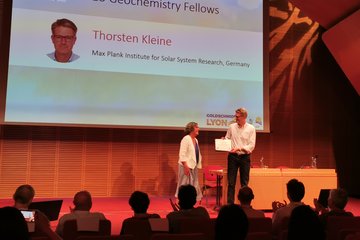Alle Typen
321.
Konferenzbeitrag
Spectra and structure functions of temperature fluctuations in the inner solar wind. In: Proceedings of the 26th ESLAB Symposium ``Study of the Solar-Terrestrial System'', S. 315 - 320. ESA Publ. Div., Noordwijk (1992)
322.
Konferenzbeitrag
Electric field fluctuations and possible dynamo effects. In: Solar Wind Seven, S. 505 - 510 (Hg. Marsch, E.; Schwenn, R.). Pergamon Press, Oxford (1992)
323.
Konferenzbeitrag
The evolution of MHD turbulence in the solar wind. In: Solar Wind Seven, S. 549 - 554 (Hg. Marsch, E.; Schwenn, R.). Pergamon Press, Oxford (1992)
324.
Konferenzbeitrag
Correlations between the level of MHD fluctuations and the bulk speed and mass flux in the solar wind. In: Solar Wind Seven, S. 555 - 558 (Hg. Marsch, E.; Schwenn, R.). Pergamon Press, Oxford (1992)
325.
Konferenzbeitrag
SUMER - Solar Ultraviolet Measurements of Emitted Radiation. In: Proceedings of Satellite Symposium 3, München, Germany, 30 March - 4 April 1992, S. 225 - 226. (1992)
326.
Konferenzbeitrag
SUMER - Solar Ultraviolet Measurements of Emitted Radiation. In: Solar Wind Seven, S. 129 - 130 (Hg. Marsch, E.; Schwenn, R.). Pergamon Press, Oxford (1992)
327.
Konferenzbeitrag
Design rationale of the Solar Ultraviolet Network (SUN). In: Proceedings of the ESO Conference on High Resolution Imaging by Interferometry II, Garching, 15.-18. Oktober 1991. (1991)
328.
Konferenzbeitrag
Signatures of coronal structures and turbulence in the solar wind. In: Proceedings of the Heidelberg Conference on ``Mechanisms of Chromospheric and Coronal Heating'', S. 162 - 164 (Hg. Ulmschneider, P.; Priest, E. R.; Rosner, R.). Springer-Verlag (1991)
329.
Konferenzbeitrag
Introduction to MHD turbulence. In: Proceedings of the MINI-Workshop on ``Physical Processes in the Solar Transition-Region and Corona'', S. 93 - 114 (Hg. Maltby, P.; Leer, E.). Institute of Theoretical Astrophysics, University of Oslo, Norway (1990)
330.
Konferenzbeitrag
On the origin of solar wind turbulence: Helios data revisited. In: Turbulence and Nonlinear Dynamics in MHD Flows, S. 81 - 86 (Hg. Meneguzzi, M.; Pouquet, A.; Sulem, P. L.). Elsevier Science Publishers B. V., North-Holland (1989)
331.
Konferenzbeitrag
Wave-particle interactions in the solar wind. In: Proceedings of the International Workshop on ``Nonlinear Phenomena in Vlasov Plasmas'', S. 145 - 162 (Hg. Doveil, F.). l'Institut d'Etudes Scientifiques de Cargèse, Corsica, France (1989)
332.
Konferenzbeitrag
Relationship between structures in the solar wind and their source regions in the corona. In: Proceedings of the Sixth International Solar Wind Conference, August 23 - 28, 1987, S. 317 - 321 (Hg. Pizzo, V. J.; Holzer, T.; Sime, D. G.). HAO/NCAR, Estes Park, Colorado, USA (1988)
333.
Konferenzbeitrag
Pick-up and collective capture of Newborn ions in the solar wind. In: Proceedings of the International Symposium on ``Plasma-Gas-Interaction'', Günzburg, F. R. Germany. (1987)
334.
Konferenzbeitrag
Energy input into the solar wind. In: Proceedings of an ESA Workshop on Future Missions in Solar, Heliospheric and Space Plasma Physics, Garmisch-Partenkirchen, Germany, 30 April - 3 May 1985, S. 11 - 21. (1985)
335.
Konferenzbeitrag
Review of Interplanetary Shock Phenomena near and within 1 AU. In: Collisionless Shocks in the Heliosphere: Reviews of Current Research, S. 33 - 50 (Hg. Tsurutani, B. T.; Stone, R. G.). American Geophysical Union, Washington, DC, U. S. A. (1985)
336.
Konferenzbeitrag
Velocity distributions of solar wind ions and electrons. In: Proceedings of a Course and Workshop on Plasma Astrophysics, Varenna, Italy, 28 Aug - 7 Sept 1984, S. 33 - 40. (1984)
337.
Konferenzbeitrag
Radial evolution of ion distribution functions. In: Solar Wind Five, S. 355 - 367 (Hg. Neugebauer, M.). (1983)
338.
Konferenzbeitrag
Ion sound turbulence in the solar wind. In: Solar Wind Four, Proceedings of the Conference held in Burghausen, August 28 - September 1, 1978, S. 299 - 304 (Hg. Rosenbauer, H.). Max-Planck-Institut für Aeronomie, Katlenburg-Lindau (1981)
339.
Konferenzbeitrag
Wave heating and acceleration of solar wind ions by cyclotron resonance. In: Proceedings of an International School and Workshop on Plasma Astrophysics, held at Varenna, Como, Italy, 27 August to 7 September 1981, S. 405 - 406. (1981)
340.
Konferenzbeitrag
Initial results on solar wind alpha particle distributions as measured by Helios between 0.3 and 1 AU. In: Solar Wind Four, Proceedings of the Conference held in Burghausen, August 28 - September 1, 1978, S. 126 - 130 (Hg. Rosenbauer, H.). Max-Planck-Institut für Aeronomie, Katlenburg-Lindau (1981)











